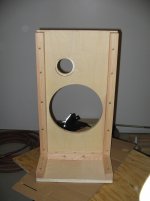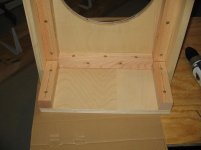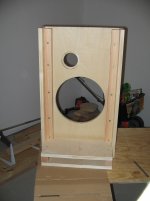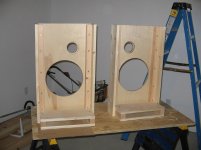After attaching the base to the bottom of the baffle, next item was to glue and screw the baffle / wing supports to the baffle. A note on the plywood. You might be able to see some chipping at the base of the plywood. This is from my power handsaw. I pre-cut with my power handsaw a little oversize and then finish cut on my portable table saw. It was easier to handle that way and none of the chipping is on the visible side.
Attachments
Securing the wings to the Baffle and supports was straight forward. I added an extra horizontal screw on each side (don’t forget to glue first) at the base to help support the overall baffle structure. Then added the top portion of the base structure where the crossover will mount. A note on the relief for the Vifa. John specified a 4.5 inch by 7/16 deep relief. Mine is only 4 inches wide. I did not have that size router bit and didn’t want to spend 30 bucks on one.
Attachments
John K., are you serious ?  this speaker (NaO micro) is just to put on your desk ?
this speaker (NaO micro) is just to put on your desk ? 
How can you have a decent output level with a 7" (125cm²) on an OB ?
I experimented with 2x7" and it was not enough !
Here the manzanita, you have a 12" (525cm²) and it can provide good level output... No comparison can be done...

How can you have a decent output level with a 7" (125cm²) on an OB ?
I experimented with 2x7" and it was not enough !
Here the manzanita, you have a 12" (525cm²) and it can provide good level output... No comparison can be done...
John K., are you serious ?this speaker (NaO micro) is just to put on your desk ?
How can you have a decent output level with a 7" (125cm²) on an OB ?
I experimented with 2x7" and it was not enough !
The low sensitivity and limited SPL are why I never really released th micro. However, look at the SPL vs cut off frequency;

If you can live with the low sensitivity then crossed into a sub at 150 Hz it can achieve 104 dB (4Pi) per side. Crossesd at 200 Hz that increases to 112dB. The problem is more one of low sensitivity.
Actually it was a very nice sounding speaker. If you compare it so something like an LS3/5a or other small 2-way monitor it holds up quite well. Nice little bedroom speaker.
2x7" will work very well in a 3-way configuration like the NaO II or Note.
Anyway, the thread was titled fast, fun, inexpensive OB. The micro fits that topic so I though I'd put it out there.
John K's design really is magnificient in it's smallness. But see there is nothing simple here, beside the carefully constructed crossover you also have a notch for the Peerless break up mode, a notch for the baffle hump and very thoroughly estimated zobel corrections. The result is a virtually flat frequency response with ample high SPL capabilities. Quite a contrast !
/Erling
/Erling
Thanks John K. Lots of great reading.
 Already looking into building one.
Already looking into building one.Looking good! Thanks for the pix. Let us know if you need any help.
The offer is appreciated.
Yes...
2x7" will work very well in a 3-way configuration like the NaO II or Note.
...
Ok John K., I understand
BTW, the speaker i tested is a BP, MTM with 2xER18RNX + 27TDFC. At the end before give up, I add a 10" (SLS263), it was a 2.5 OB speaker. I don't like a lot the ER18RNX as full midrange but it is a fantastic low mid.
I found only one photo...
An externally hosted image should be here but it was not working when we last tested it.
Uploaded with ImageShack.us
You might enjoy checking out the OB speaker system I built. I researched the subject rather thoroughly, and tried not to cut any significant corners. It's tri-amp'd with the OB EQ ahead of the poweramps to avoid the huge efficiency loss. It's not at all quick and easy, but you may learn a few things. Click on "Audio", then on the "Aurium Waveguide".
http://www.spiritone.com/~rob_369
http://www.spiritone.com/~rob_369
It's not at all quick and easy, but you may learn a few things. Click on "Audio", then on the "Aurium Waveguide".
http://www.spiritone.com/~rob_369
Sweet stuff!!!
PM sent
Sweet stuff!!!
indeed, lots of work there, and fun
the 45 record cleaner put a smile on

but the old brass keyhole on the tube amp, that really made me laugh
best one today

You might enjoy checking out the OB speaker system I built. I researched the subject rather thoroughly, and tried not to cut any significant corners. It's tri-amp'd with the OB EQ ahead of the poweramps to avoid the huge efficiency loss. It's not at all quick and easy, but you may learn a few things. Click on "Audio", then on the "Aurium Waveguide".
http://www.spiritone.com/~rob_369
Thanks Bob. About two hours ago, I learned firsthand about the "huge efficiency loss".
Looks very nice, thanks for the link, Bob.
To get decent bass out of a small open baffle, you need power. That's physics talking.
Unfortunately, it doesn't work that way - there is no free lunch. If you use active or passive EQ, you still need the power. You either boost the bass (active) or cut the mids (passive). It comes out the same, minus the DCR losses in the passive crossover.It's tri-amp'd with the OB EQ ahead of the poweramps to avoid the huge efficiency loss.
To get decent bass out of a small open baffle, you need power. That's physics talking.
Looks very nice, thanks for the link, Bob.
Unfortunately, it doesn't work that way - there is no free lunch. If you use active or passive EQ, you still need the power. You either boost the bass (active) or cut the mids (passive). It comes out the same, minus the DCR losses in the passive crossover.
To get decent bass out of a small open baffle, you need power. That's physics talking.
Actually it does not out the same. In either case current and voltage across the VC must be the same for the same response. And the power dissipated in the VC will be the same. But, in an active case that current and voltage is, except for cable losses, the current and voltage at the amplifier terminals. In a passive case the current and voltage at the amplifiers terminals are very different, placing a greater load on the amp. Efficiency may be the wrong word, but just because reactive components do not dissipate power does not mean they do not suck power from the amp. The situation is that sometimes they draw power from the amp and sometimes give it back.
So while power dissipated may be the same, passive eq placed additional demands on the amplifier which may limit its ability you reproduce a complex signal without current or voltage clipping.
Take the simple example of a notch filter with -6dB depth. If that notch is passive then the amplifier voltage with be twice the voltage that is actually applied across the driver at the notch center frequency. If it is done actively, the amplifier only produces required output voltage, giving 6dB of head room for other frequency components in the signal.
Well John, it looks like we about 1/2 agree.  From my point of view, it pretty much all comes out the same. True, with the active filter you don't have the big inductive load, but most amps don't seem to mind it.
From my point of view, it pretty much all comes out the same. True, with the active filter you don't have the big inductive load, but most amps don't seem to mind it.
From a practical standpoint with an OB like this, your bass loss sets how much power you will need. For example:
The amp still needs to output 9V to hit 92dB at the low end, so you need the same size amp, whether active or passive. The passive version has to output the higher voltage across the entire bandwidth, so it's using more power, right? No, it's not. Because the passive crossover has a rising impedance with frequency (that's how it does its EQ) the same voltage into the higher impedance means - less power, of course. P=V2/R
There are differences in the two approaches and benefits of one over the other, but we still need to calculate headroom by the least efficient frequency you use.
All that said, this a build thread, not a theory thread, so I won't belabor the point. If you use an open baffle, just be sure you have an amp that will give you enough headroom. You don't get something for nothing.
OK, then were does the power go? You say it's not dissipated by the crossover and the current and voltage at the driver are the same. Where is the extra power dissipated?In a passive case the current and voltage at the amplifiers terminals are very different, placing a greater load on the amp. Efficiency may be the wrong word, but just because reactive components do not dissipate power does not mean they do not suck power from the amp.
True - but only inside the notch. What about all the frequencies around the notch? Don't they need the same voltage they ever did? How do they benefit from more headroom? They don't. Yes, if you notch out a frequency via a passive shunt, then the amp will have to supply more power inside the notch. But that has little to no effect on the frequencies surrounding the notch.Take the simple example of a notch filter with -6dB depth. If that notch is passive then the amplifier voltage with be twice the voltage that is actually applied across the driver at the notch center frequency. If it is done actively, the amplifier only produces required output voltage, giving 6dB of head room for other frequency components in the signal.
From a practical standpoint with an OB like this, your bass loss sets how much power you will need. For example:
- Your woofer (at 1 meter) gives you 92dB@2.83V
- Open baffle bass loss causes the low end to drop 10dB
- Now the low end of the woofer response is 82dB@2.83V
- To get back to 92dB you need about 9V
- Cut the rising curve by 10dB
- Boost the falling curve by 10dB
- Split the difference and use 5dB boost and 5dB cut
The amp still needs to output 9V to hit 92dB at the low end, so you need the same size amp, whether active or passive. The passive version has to output the higher voltage across the entire bandwidth, so it's using more power, right? No, it's not. Because the passive crossover has a rising impedance with frequency (that's how it does its EQ) the same voltage into the higher impedance means - less power, of course. P=V2/R
There are differences in the two approaches and benefits of one over the other, but we still need to calculate headroom by the least efficient frequency you use.
All that said, this a build thread, not a theory thread, so I won't belabor the point. If you use an open baffle, just be sure you have an amp that will give you enough headroom. You don't get something for nothing.
- Home
- Loudspeakers
- Multi-Way
- Fast, fun, Inexpensive OB project



